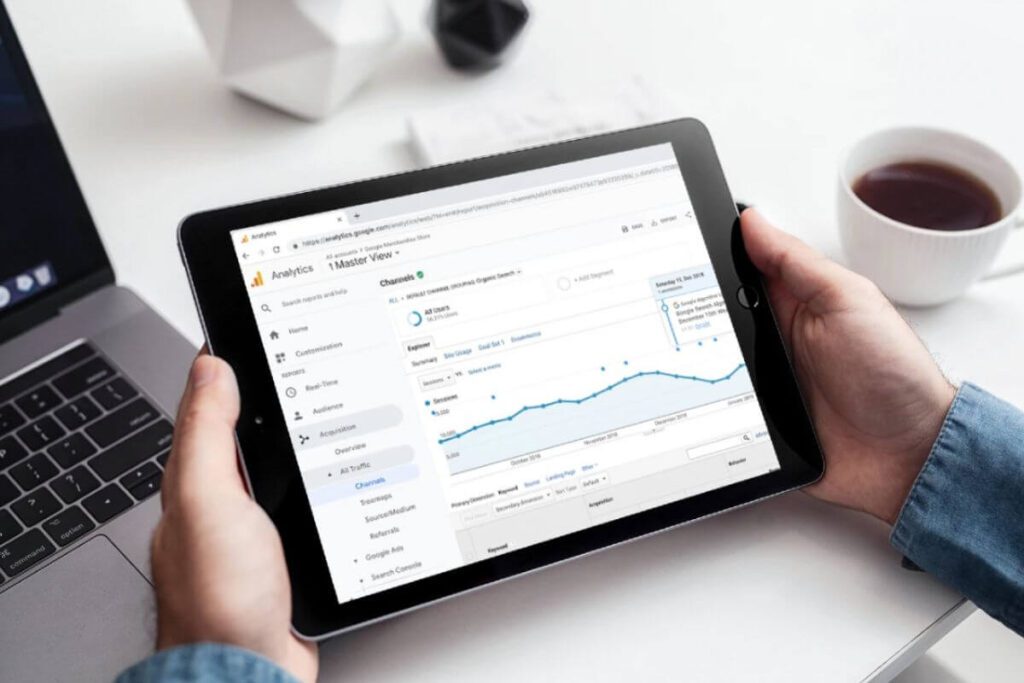In today’s digital world, having a well-referenced website is essential for attracting traffic and developing your business. Search Engine Optimization (SEO) is a set of techniques designed to improve a website’s visibility on search engines such as Google.
In this article, we’ll explore 10 best practices for optimizing your website’s SEO and improving your Google ranking.

Keyword search
Keyword research is the first crucial step in any SEO strategy. It involves identifying the terms your potential customers use to search for products or services similar to yours.
Understanding these terms allows you to optimize your content and position yourself effectively on search engines, attracting qualified traffic to your site.
Keyword Search Tools
Use tools like Google Keyword Planner, SEMrush or Ahrefs to find relevant keywords and evaluate their search volume and competitiveness.
These tools provide valuable data on how often certain terms are searched and how difficult it is to rank for them, helping you to identify the best opportunities for your SEO strategy.
Keyword selection
Choose keywords that are relevant to your business, with good search volume and moderate competition. Avoid keywords that are too generic, and favor those that are specific to your niche. For example, instead of targeting a broad keyword like “shoes”, opt for more specific terms like “women’s running shoes”.
It’s also important to include your location in your keyword selection. For example, if you’re an artisanal shoe manufacturer in a specific region, a specific keyword like artisanal shoes in Abomey would be perfect for your local SEO.
This approach enables you to attract more qualified visitors, who are more likely to be interested in your specific products or services.
Keyword research remains an essential step in any effective SEO strategy. By using specialized tools and selecting your keywords wisely, you can improve your online visibility and attract more relevant traffic to your site.

On-Page Optimization
Title tags and meta descriptions must contain your main keywords. These elements are essential for SEO and play a crucial role in the click-through rate (CTR) of your pages.
Make sure title tags are concise, informative and attractive, enticing users to click. It’s also important to include the page’s main keyword.
Meta descriptions, while not having a direct impact on SEO ranking, must also be convincing and include calls to action to attract the attention of web users.
Use of Headers (H1, H2, H3, etc.)
Use header tags to structure your content in a logical and readable way. The H1 tag should contain your main keyword and summarize the page’s subject. H2 and H3 tags should be used for subheadings, dividing the text into clear, hierarchical sections.
On Pages specialists recommend including secondary keywords related to your subject in these tags. This allows you to intelligently include other keywords related to your subject, with a view toincreasing your organic traffic.
This structure not only helps search engines understand the content of your page, but also improves the user experience by making the text easier to read.
Quality Content
Create content that is informative, well-written and relevant to your audience. Content should be original and add real value for your readers. Avoid duplicate content and make sure that each article or page answers a specific question or need of your target audience.
Reader engagement is a key factor in SEO, so the more useful and engaging your content is, the more likely it is to generate organic traffic and retain visitor interest.

Image optimization
The use of alt tags and descriptive titles for your images is essential for improving your site’s accessibility and SEO. Alt tags (or alt attributes) provide alternative text for images, enabling search engines to better understand the image content and associate it with relevant keywords.
They are also crucial for visually impaired users of screen readers. It’s advisable to write clear, concise descriptions for each image, incorporating relevant keywords without overusing them.
Image compression is a crucial step in optimizing your website’s loading speed. Uncompressed images can significantly slow down loading times, which can have a detrimental effect on your site’s user experience and SEO.
To avoid this, use tools such as TinyPNG or ImageOptim, which allow you to compress your images without any significant loss of quality. These tools reduce file size while maintaining optimal visual quality, helping to improve your site’s overall performance. Improved loading speed can also have a positive impact on your conversion rate and ranking in search results.
By integrating these image optimization practices, you not only improve your site’s accessibility and efficiency, but also deliver a better user experience, which is essential to attracting and retaining visitors.

Improving Site Speed
Website loading speed plays a crucial role in user experience and search engine ranking, especially on Google. A site that loads quickly holds visitors’ attention better, reduces the bounce rate and increases the chances of conversion.
Google favors fast sites in its search results, which can significantly improve your online visibility. To assess your site’s speed and identify areas for improvement, you can use tools like Google PageSpeed Insights. This tool provides you with detailed reports and practical suggestions for optimizing your site’s performance.
Image optimization: Compress your images without compromising their quality to reduce loading times. Tools such as TinyPNG and ImageOptim can be very useful for this.
Using Caching: Caching temporarily stores copies of your web pages, speeding up loading for repeat visitors. Configure your site’s caching correctly to improve performance.
Reduce the number of HTTP requests: Every element on your page (images, scripts, style sheets) requires an HTTP request. Reduce the number of these requests by consolidating your CSS and JavaScript files, and minimizing the use of non-essential plugins and extensions.
Using a CDN (Content Delivery Network): A CDN distributes your site’s content from several servers located in different parts of the world. This reduces latency and speeds up loading times for users located far from your site’s main server. Consider using CDN services like Cloudflare or Akamai to improve your content distribution.

Mobile-Friendly Design
With the explosion in the use of mobile devices to browse the Internet, it’s essential that your website is responsive and optimized for mobile. A mobile-friendly site automatically adapts to the user’s screen size, offering a smooth and enjoyable browsing experience, whether on a smartphone, tablet or desktop computer.
Google also favors mobile-friendly sites in its mobile search results, which can improve your ranking and attract more visitors. By neglecting mobile optimization, you risk losing a significant share of your audience and damaging your conversion rate.
To make sure your site is well adapted to mobile devices, use Google’s mobile compatibility test tool. This tool allows you to check how your site displays on mobile devices and identify potential problems. Here are some key aspects to check:
Text legibility : Make sure that text is large enough to be read without the user having to zoom in. Use appropriate fonts and ensure that contrasts are sufficiently sharp for comfortable reading.
Button accessibility : Buttons and links should be large enough and spaced far enough apart to be easily clicked with a finger. Avoid interactive elements too close together to prevent accidental clicks.
Mobile Loading Speed: Loading speed is even more crucial on mobile devices. Optimize your images, use caching and reduce file sizes to ensure fast loading on mobile networks, which are often slower than wired connections.
Responsive layout: Use responsive design techniques to adapt your site’s layout to different screen sizes. CSS Media Queries and frameworks such as Bootstrap can help create flexible layouts that adjust perfectly to any type of device.
Real Testing on Various Devices: Beyond automated testing, try navigating your site from different devices and browsers to ensure that the user experience is consistent and satisfying everywhere.

Regular Content Creation
The regular publication of blog articles is an effective strategy for attracting traffic to your website and improving your SEO. Search engines like Google favor sites that offer fresh, relevant, quality content.
By publishing regular articles, you not only increase your site’s indexing frequency, but also give your visitors reasons to return. An active, well-fed blog can position your site as an authority in your field, building trust and engagement with your audience.
To maximize the impact of your blog, it’s crucial to develop a well thought-out content strategy. Here are some key steps to developing an effective content strategy:
Topic planning: Identify topics of interest to your target audience and relevant to your industry. Use keyword research tools to discover trends and frequently asked questions related to your field. Create a list of topics for future blog posts.
Editorial Calendar: Create an editorial calendar to organize your publications. An editorial calendar helps you maintain a regular rhythm and plan publication dates in advance. You can include information such as publication dates, article titles, assigned authors and production stages (research, writing, proofreading, publication).
Content diversity: Vary the types of content you publish to keep your audience interested. You can offer feature articles, how-to guides, case studies, interviews, infographics, videos and more. Content diversity allows you to reach different segments of your audience and cater to their diverse preferences.
SEO Optimization: Make sure every article is optimized for SEO. Use relevant keywords in titles, subtitles and body text. Add meta tags, descriptions, and internal and external links to improve search engine visibility.
Engagement and Interactivity: Encourage your readers’ engagement by asking them questions, soliciting their opinions or offering to share their experiences in comments. Reply to comments to create interaction and build audience loyalty. You can also share your articles on social networks to increase their reach and attract new readers.

Quality backlinks
Importance of backlinks
Backlinks play a crucial role in your website’s SEO. A backlink is a hypertext link from another website to yours. Search engines, especially Google, consider backlinks as votes of confidence.
When a high-authority site links to your content, it tells search engines that your site is credible and trustworthy. As a result, quality backlinks can improve your ranking in search results, increase your online visibility and attract more qualified traffic.
Strategies for obtaining backlinks
To obtain quality backlinks, it’s essential to implement effective and ethical strategies. Here are a few tried-and-tested methods for acquiring relevant, natural backlinks:
Guest Writing: Offer to write guest articles for influential blogs or websites in your niche. In exchange for your quality content, you can include one or more links to your site. Make sure the sites you publish on are reputable and relevant to your field.
Participation in Niche Forums: Get involved in online forums and communities related to your sector. Actively participate in discussions, answer questions and share your expertise. Where appropriate, include links to useful resources on your site. Make sure these links add real value to the discussions.
Collaboration with Influencers: Collaborate with influencers and opinion leaders in your field. Influencers can write reviews of your products, share your articles, or mention your site in their publications. These collaborations can generate high-quality backlinks and raise your profile.
Creating valuable content: Produce exceptional content that’s worth sharing. In-depth articles, case studies, infographics and how-to guides are examples of content that can attract backlinks naturally. The more useful and relevant your content, the more likely it is to be cited by other sites.
Resource Directory: Create resource pages or comprehensive guides on specific topics in your field. These pages can become references that other sites will want to link to in order to provide value to their own readers.
Backlink recovery: Use SEO tools to identify broken backlinks or unlinked mentions of your brand. Contact the webmasters of the sites concerned and offer to replace the broken links with links to your site, or to add a link where your brand is mentioned.

Use of Social Networks
Content Sharing
Social networks are powerful tools for increasing the visibility of your content and driving traffic to your website. By regularly sharing your articles, videos, infographics, and other types of content on platforms such as Facebook, Twitter, LinkedIn, Instagram, and Pinterest, you can reach a wider and more diverse audience.
Here are a few tips to optimize the sharing of your content on social networks:
Tailor Content: Personalize your publications for each platform. For example, use eye-catching visuals for Instagram, in-depth articles for LinkedIn, and concise tweets for Twitter. Also adapt the tone and style of your posts to suit your audience on each network.
Use relevant hashtags: Hashtags can increase the reach of your publications by making them easier to find for users interested in specific topics. Use hashtags that are relevant and popular in your field to maximize the visibility of your content.
Publication Calendar: Set up a publication calendar to share your content regularly. Schedule your posts at times when your audience is most active to increase engagement. Tools like Buffer or Hootsuite can help you schedule your posts in advance.
Community involvement
Engaging with your community on social networks is essential to building strong, loyal relationships with your audience. Here are some strategies for interacting effectively with your followers:
Respond to Comments: Take the time to respond to comments left by your followers. Whether positive or negative, responding to comments shows that you value your audience’s opinions and are listening. This can reinforce loyalty and encourage more interaction.
Ask Questions: Encourage engagement by asking questions in your publications. Ask your audience’s opinion on relevant topics, or solicit suggestions and ideas. Open-ended questions encourage followers to actively participate and share their perspectives.
Encourage shares: Invite your followers to share your content with their own networks. The more your content is shared, the wider and more diverse the audience it will reach. You can organize contests or specific campaigns to encourage shares and increase your reach.
Create Interactive Content: Use polls, quizzes, and stories to engage your audience interactively. These formats encourage followers to interact directly with your content, increasing engagement and visibility.
Collaborate with Influencers: Collaborate with influencers or partners in your field to extend your reach. Influencers can introduce your content to their own audience, which can attract new followers to your brand.

Analysis and follow-up
Analysis tools
To effectively optimize your website and SEO strategy, it’s essential to use robust analytics tools. Google Analytics and Google Search Console are two indispensable tools for tracking your site’s performance and gaining valuable insights into user behavior.
Here’s how these tools can help:
Google Analytics: This tool lets you track and analyze a wealth of data about your website. You can find out the number of visitors, traffic sources, user behavior, most-visited pages, and much more.
By analyzing this data, you can identify what’s working well and what needs improvement. For example, you can discover which pages have a high bounce rate and work to optimize them to retain visitors longer.
Google Search Console: This tool is specifically designed to monitor and maintain your site’s presence in Google search results. It provides you with information on your keyword performance, clicks, impressions, and positions in the search results.
What’s more, Google Search Console alerts you to potential technical problems, such as crawl errors, security issues, and mobile usability improvements. By resolving these issues, you can improve your site’s visibility and indexing.
Key KPIs
To evaluate the effectiveness of your SEO and digital marketing efforts, it’s crucial to monitor key performance indicators (KPIs). Here are some essential KPIs to track:
Bounce Rate: The bounce rate measures the percentage of visitors who leave your site after viewing a single page. A high bounce rate may indicate that visitors can’t find what they’re looking for, or that the user experience needs to be improved. Analyze pages with high bounce rates to identify potential problems and make improvements.
Time Spent on Site (Average Session Duration): This metric indicates the average duration of user sessions on your site. A high average session duration suggests that visitors find your content interesting and engaging. To increase this duration, offer quality content, in-depth articles and relevant internal links to encourage users to explore your site further.
Page Views: The number of page views gives you an idea of user interest in your content. The more pages are viewed, the more visitors explore your site. Analyze which pages are the most popular and why, then use these insights to create more similar content or improve underperforming pages.
Conversion Rate: This KPI measures the percentage of visitors who complete a desired action, such as filling in a contact form, subscribing to a newsletter, or making a purchase. Tracking this rate helps you assess your site’s effectiveness in turning visitors into customers. Optimize your calls to action (CTAs) and improve the user experience to increase this rate.
Traffic Source: Knowing your site’s traffic sources (organic, direct, referral, social, etc.) helps you understand which marketing strategies work best. For example, if a large proportion of your traffic comes from organic search, it means your SEO efforts are paying off.

Continuous Improvement
A/B testing
A/B testing is an effective way of comparing different versions of your content to determine which produces the best results.
By conducting A/B tests, you can test specific variations of an element on your site, such as a title, an image, a call to action (CTA) or even the page layout. Here’s how it works:
Identify the element to test: Choose an element of your site that you’d like to improve. This could be a landing page, a CTA button, an image, or text. Make sure this element has a significant impact on conversions or user engagement.
Creating variants: Create two different versions of this element. For example, if you’re testing a CTA button, you could have version A with the text “Buy Now” and version B with “Add to Cart”. It’s important to modify only one element at a time to isolate the effects of each change.
Fair Traffic Distribution: Use an A/B testing tool, such as Google Optimize, to divide traffic randomly and equally between the two versions. This ensures that results are not skewed by external variables.
Results Analysis: Once you’ve collected enough data, analyze the results to see which version performed best. Metrics to monitor may include conversion rate, time spent on page, click-through rate, etc.
Implement the Best Version: Once you’ve identified the winning version, implement it on your site. Repeat this process regularly to continually improve the elements of your site.
Adjustments and Optimizations
Optimizing your website is never a finite process. Search engine algorithms are constantly evolving, as are user expectations and behaviors.
To stay competitive and maintain good SEO, it’s crucial to adopt a proactive approach to continuous adjustment and optimization. Here are some key steps to follow:
Performance monitoring: Use analysis tools such as Google Analytics and Google Search Console to continuously monitor your site’s performance. Identify trends, low-performing pages and opportunities for improvement.
Adopting New SEO Practices: Google’s algorithms are updated regularly. Keep abreast of the latest SEO trends and practices to ensure your site complies with new requirements. For example, optimization for voice and mobile searches is becoming increasingly important.
Content Optimization: Regularly update your content to keep it relevant and engaging. Add new information, improve existing articles, and remove obsolete content. Make sure your keywords are always relevant and that your content meets your audience’s expectations.
Enhanced User Experience (UX): User experience is a key factor in SEO and visitor retention. Improve your site’s navigation, reduce loading times, and make sure your site is accessible on all devices. Solicit regular feedback from your users to identify friction points.
Competitor monitoring: Analyze your competitors’ sites to identify their strategies and discover opportunities to improve your own site. Use tools like SEMrush or Ahrefs to carry out an in-depth competitive analysis.
Things to remember
Optimizing your website’s SEO is an ongoing process that takes time and effort. By following these 10 best practices, you can significantly improve your Google ranking, attract more visitors, and grow your online business.
Keep up to date with the latest SEO trends and updates withExpertise Web Marketing agency to maintain and improve your results over time.


